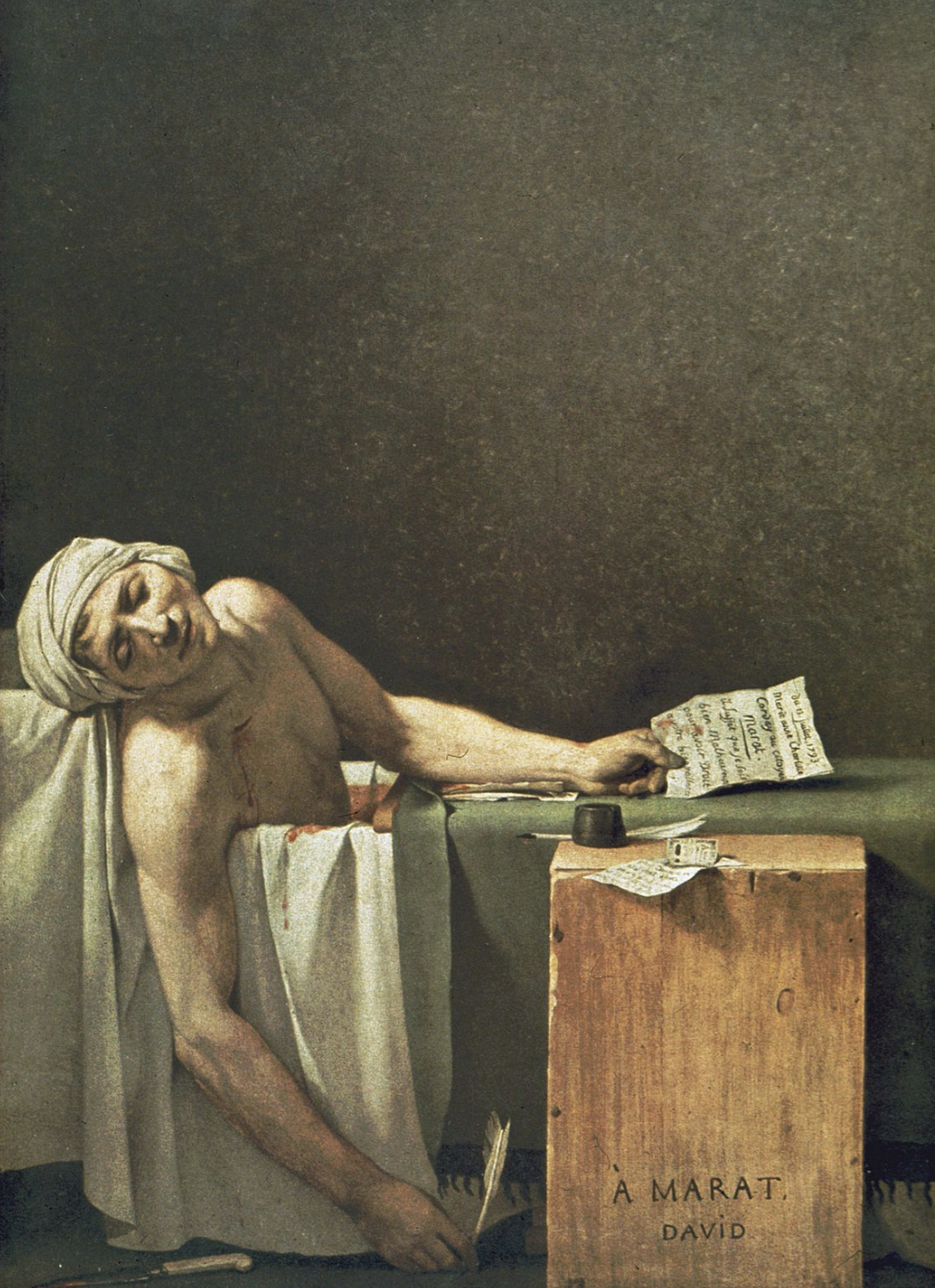Selected Works Final
1/31
There's no tags or description
Looks like no tags are added yet.
Name | Mastery | Learn | Test | Matching | Spaced |
|---|
No study sessions yet.
32 Terms
The Merode Altarpiece by Robert Campin, patron Inghelbrechts, Early Renaissance
Inghelbrects are on the left side of the panel, the piece later was owned by the Merode family. The painting is small and could have been carried around since it folded up (tryptic). They could pray to this piece in their own home. Large amount of objects in the center piece alongside Mary and the Ark angel Gabriel. Joseph is seen on the right panel in the wood shop. Artist has created a recession into space but things aren’t 100% proportional
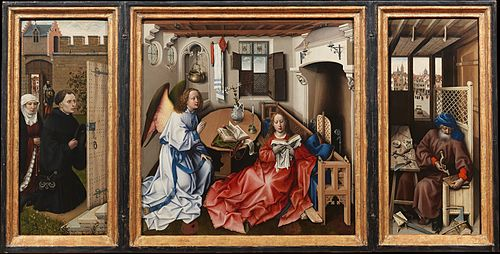
Saint Mark by Donatello, or San Michele, Florence, Early Renaissance
Statue was in the niche in ____ city hall that would have belonged to the linen drapers guild. The statue is 7ft 11in and carved to be seen from the street below (body is lengthened, legs are shortened). Meant to resemble Greek/Roman art, Florence wanted to emphasize their status as a successor of Earlier Roman cities. In contrapposto, lots of detail in the cloth, head has slightly thinning hair, serious expression, seems like a present, realistic figure.
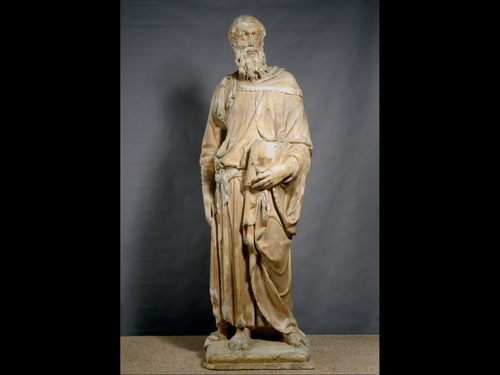
Holy Trinity by Masaccio, patron Gonfaloniere Lenzi, Florence, Early Renaissance
True fresco (21ft high), strong architectural frame, feels as though we’re looking through the wall of a church into a side chapel. Features strong architectural features (Corinthian columns, barrel vault with coffers, ionic columns). Holy Trinity: father, son and the Holy Ghost, God holds the cross and right on his chest is the dove of the holy spirit. At the foot of the cross, the Virgin Mary is on the left and St. John is on the right. Patrons are right on the steps outside the church. ___ has figured out how to utilize single point perspective. Below where the altar would be, there is a stone sarcophagus with a skeleton who seems to be speaking to the viewer.
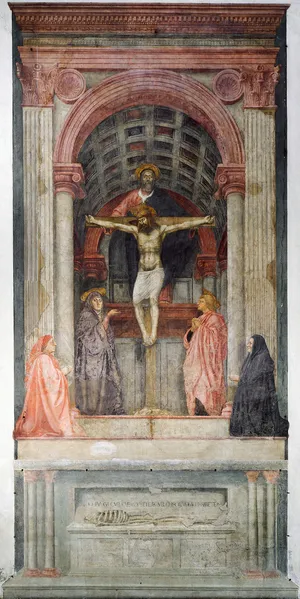
Palazzo Medici-Riccardi by Michelozzo, Florence, Early Renaissance
Originally had large arch openings where the windows are now and people would do banking business on the first floor. Stone work at each level is different: first floor has irregular stones (russification), second floor has more regular bricks but cement layers are set back a bit, leading to shadows, third floor has smooth blocks and the mortar is flush with the bricks, leading to it being completely smooth. At the top, there are small protruding blocks carved out with coffers that have rosettes in them. Inner courtyard was used for entertaining people and holding events, courtyard itself is very geometric, square w/ three arches on each side, frieze with Medici coat of arms, Corinthian columns.
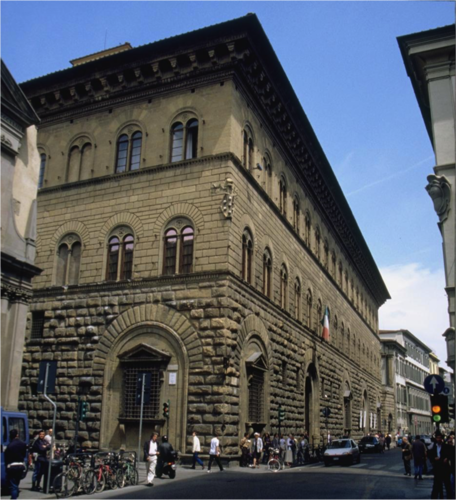
David by Donatello, patron Medici, Early Renaissance
Believed this statue would have been set out in the ___ courtyard. Made of bronze, life-sized. David is a patron and protector of Florence, Gloiath’s head lays at his feet. This figure is heroically nude, one of the first nude figures seen since ancient Greece. In contrapposto, hat has a laurel wreath. He carried Goliath’s sword, his slingshot is in his left hand.
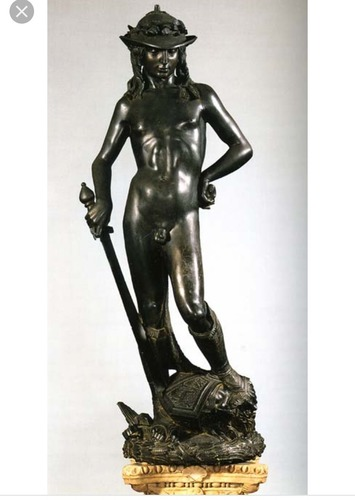
Birth of Venus, Botticelli, ca. 1482, for Medici Villa
9ft across, painted using tempura paint. Believed this painting may have been based on a poem that a hymn to Aphrodite using the style of Latin poetry, in it Aphrodite is compared to the Virgin Mary (expressions of divine love—both have purity and beauty). Ideas of rebirth and water (Aphrodite is the love letter between the divine and the sea). Aphrodite’s figure is based off of Roman statues, she is in contrapposto, ___s even owned a copy of the Aphrodite of Knidos statue. Two figures on the left are the west wind blowing Aphrodite ashore and his wife, Flora, throwing flowers onto Venus. Nymph on the right is running over to cover Aphrodite
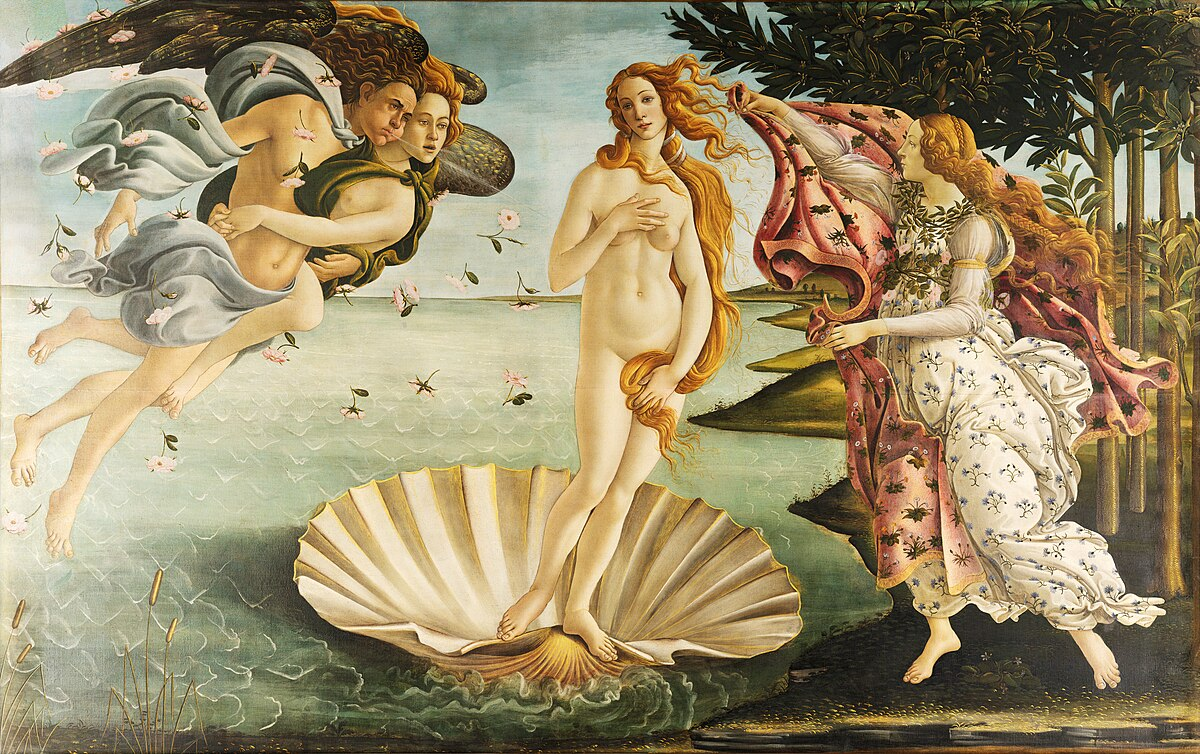
David by Michelangelo, Florence, High Renaissance
Statue was going to be placed in a cathedral at the center of Florence, much larger since it had to be visible from far away (14ft 3in). David from the old testament, was the patron of Florence. David was then placed in front of city hall at street level. David here is much older than other figures, he doesn’t have the head of goliath at his feet. He seems to be looking at something in the distance (Michelangelo seemed to be showing David watching out for Goliath in the distance. Could be a warning for the people of Florence to watch out to threats to their republic (Medici family plotting to return to power)
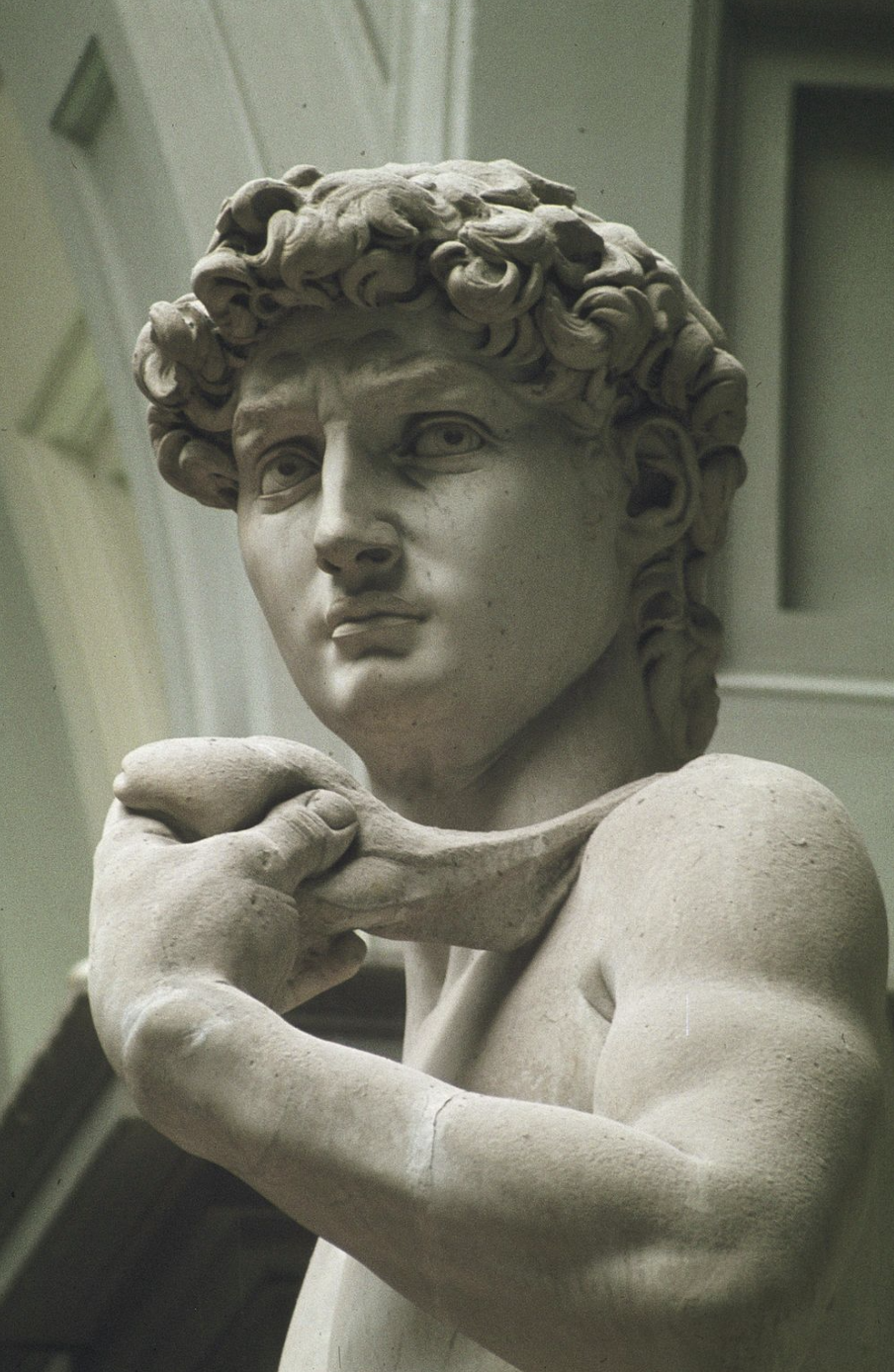
Tempietto by Bramante, Rome, High Renaissance
Paid for by the king and queen of Spain at the time. Bramante was originally trained in painting, learned architecture by sketching buildings he saw in Rome. Structure is not a church, more similar to a cloister, made to just be seen from the outside. Frieze above columns has triglyphs and metopes that contain Christian elements. Same components as in a rectangular temple but in a sphere (3 steps, columns, Doric order columns, etc.). Second story has 16 panels to mimic 16 columns below, half sphere dome above has 16 ribs. Plato has said that a circle was the perfect sign of the divine because of its eternal nature (perfect structure to house a church).
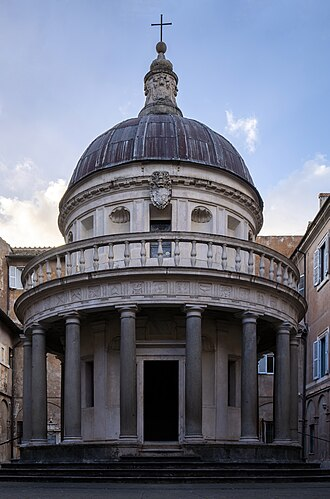
Last Supper by Leonardo de Vinci, Sta. Maria delle Grazie, Milan, High Renaissance
De Vinci was part of the Court of the Duke of Milan, was friends with the head of this monastery, painting was in front of the area where the monks would gather to eat. De Vinci painted on gesso using tempura and oil paint, paint began to buckle and crack and paint flaked off. De Vinci portrays each disciple’s personality through their reaction to the information that one will betray Christ (as compared to earlier stiffer depictions of the Last Supper). Figures are also grouped into groups of 3, not just equally spaced apart. Small hints as well that Judas is a traitor, his hand is in the dish Christ's has just been in and his hand is on the table.
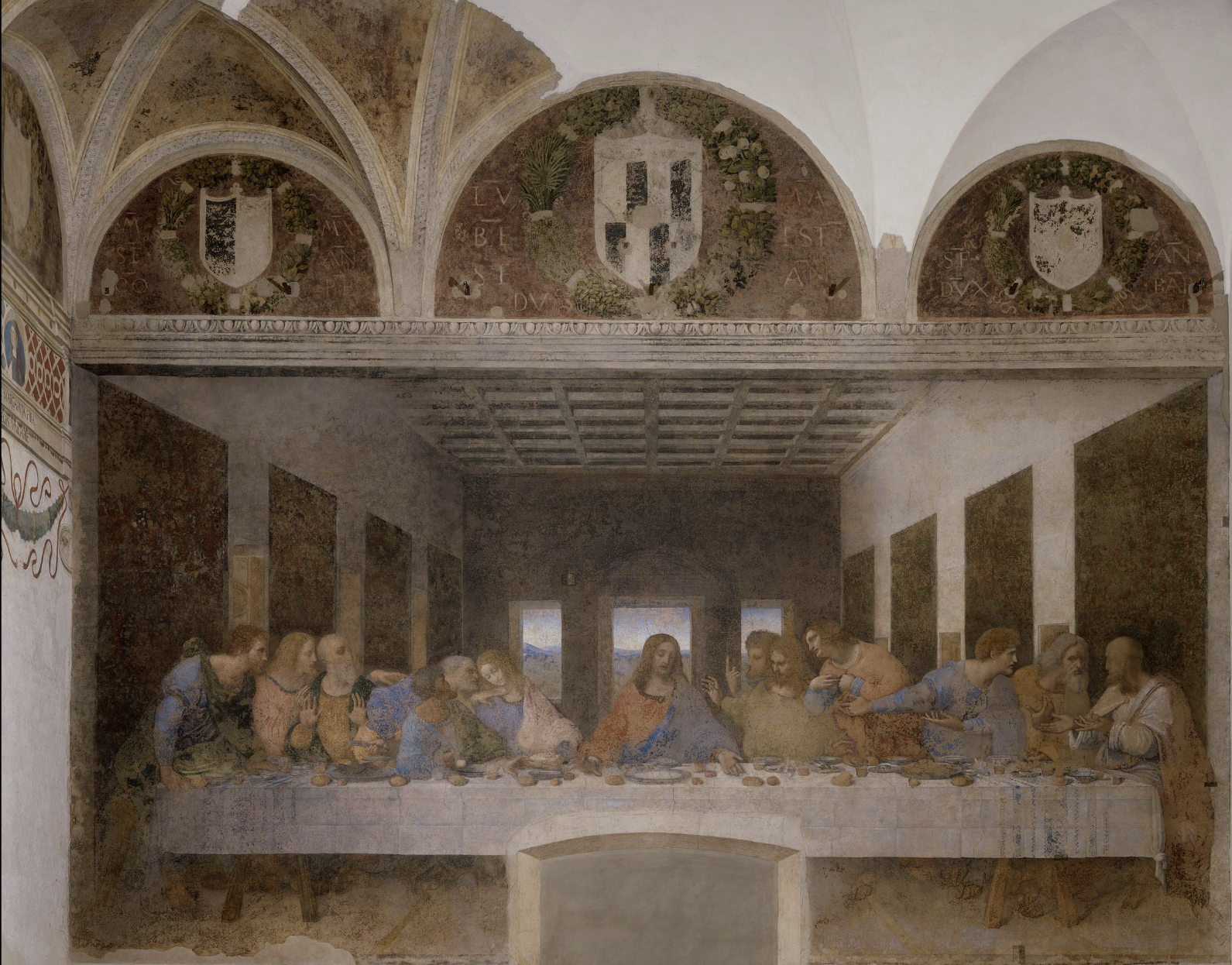
Disputa by Raphael, Stanza Della Segnatura, High Renaissance
Pope Cesear’s personal library, he allowed the sale of indulgences where people could pay money to go straight to heaven. Fresco technique was used throughout this room to create the paintings. Vanishing point is an object located on the altar, a wafer meant to be turned into the body of Christ. Christ is at the top with the Virgin Mary on the left, figures on the clouds include disciples and figures from the old testament mixed together. Below this, four angels are holding up pages of the new testament. Raphael sketched every figure nude before painting clothes on to ensure anatomy was correct.

Philosophy (School of Athens) by Raphael, Stanza Della Segnatura, High Renaissance
All architectural elements are reminiscent of Greece and Rome (barrel vaults, niches, columns, etc.), features statues of Pagan gods. Vanishing point is between Plato (heavenly ideal) and Aristotle (Earth and Sciences) who are framed by an arch. The two are surrounded by great scientists and philosophers from throughout time. Aristotle claims we learn by observing our world (which is why his hand is out). Contains depictions of geometry since its intertwined so deeply with Greek philosophy. Was located directly across from the theology painting, showcased equal status of philosophy and theology
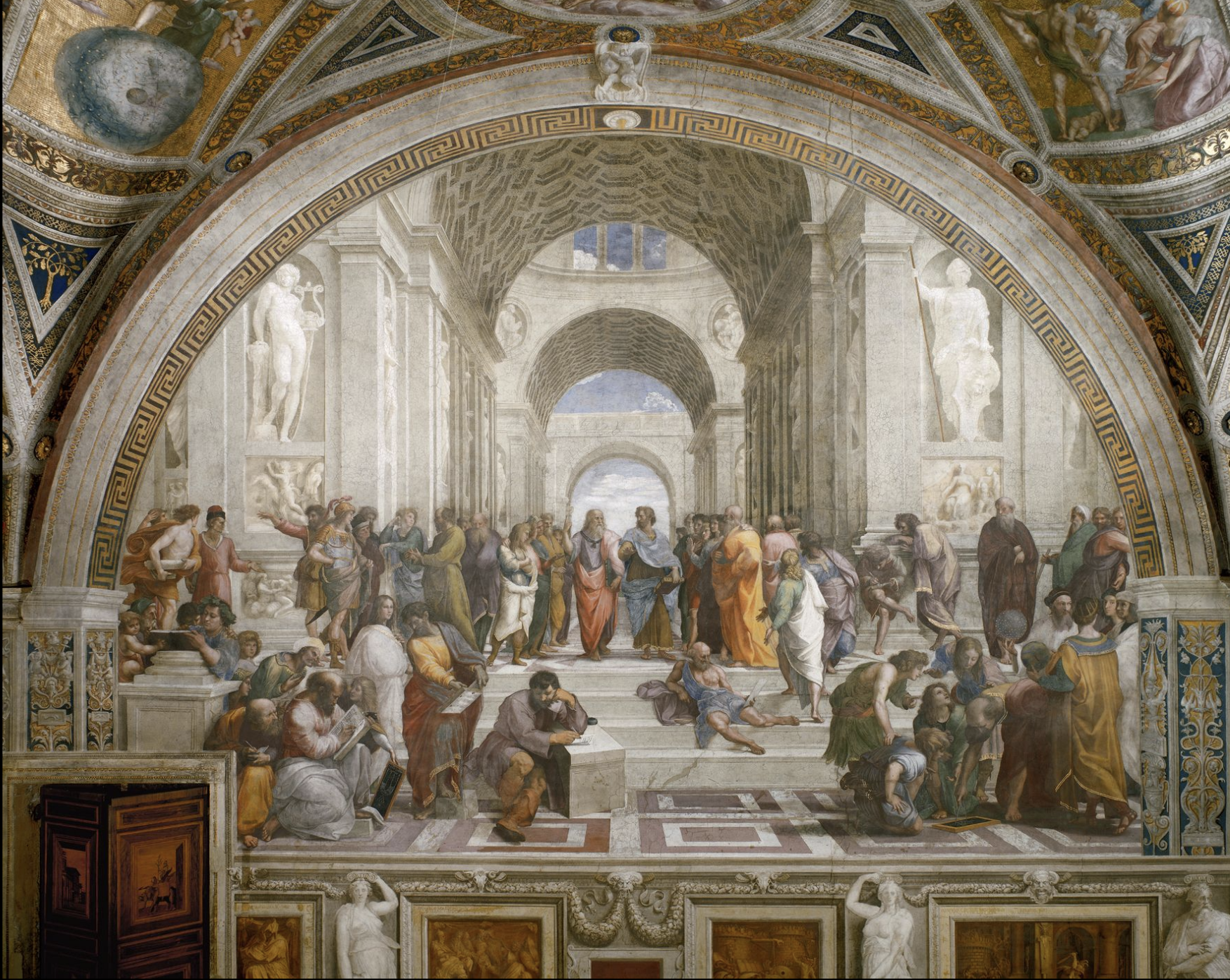
The Four Apostles, Durer, Nuremberg, 1526
Durer lived in Nuremberg who voted to become Protestant. Seems to be an altar piece but is incomplete (not sure if on purpose). St. Peter is on the left holding the key to heaven but he is in the back and is looking down at St. John holding the bible. The bible in St. John’s hand is open to a page describing how the word of God is most important above all else (Protestant ideal). Martin Luther’s translated passages are on the bottom, he translated the bible so anyone could read it without needing to know Latin and/or go through church officials. These images were not made to be worshipped in a church, instead they were given to Nuremberg city hall
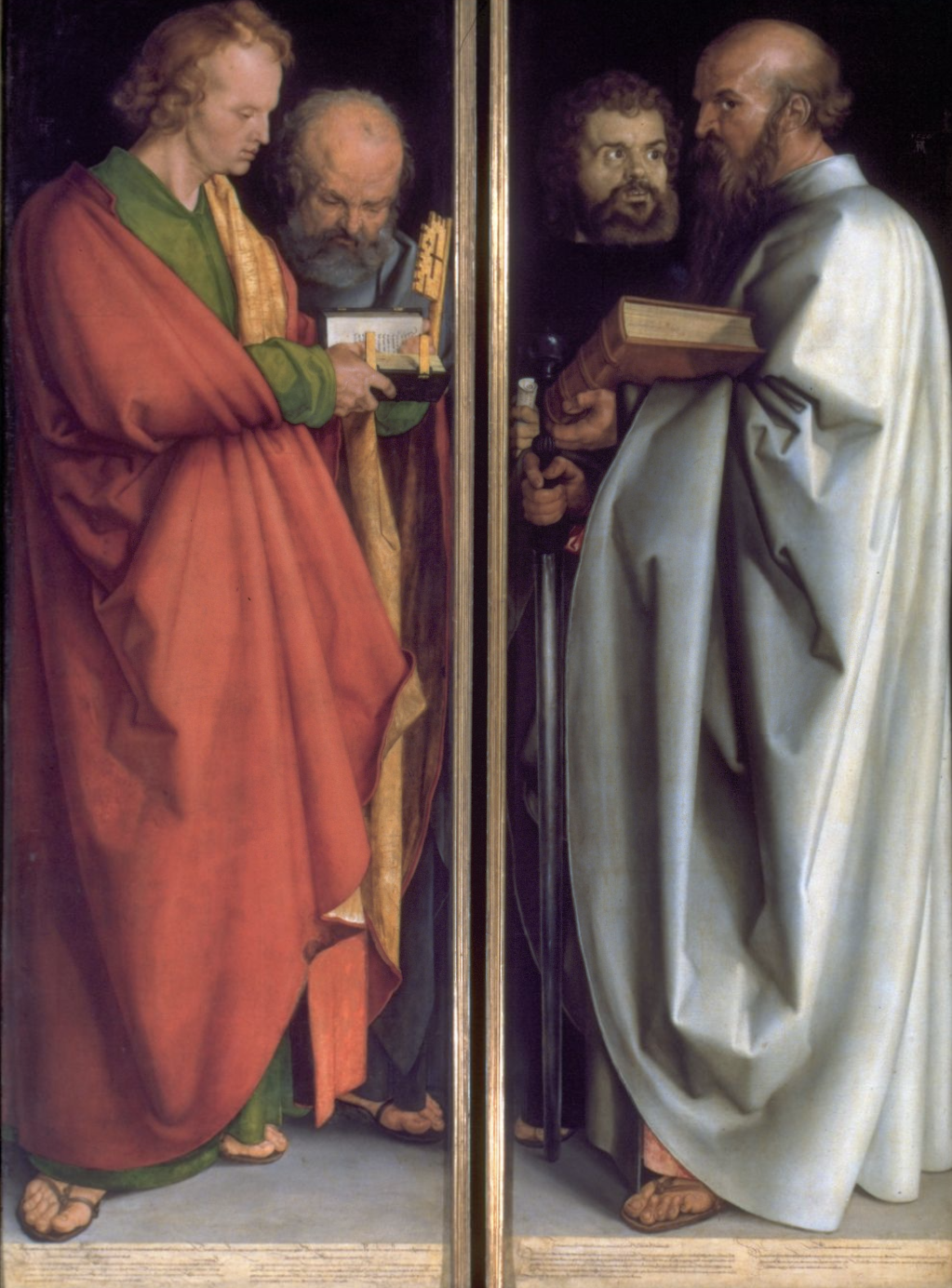
Ecstasy of St. Theresa, Bernini, Cornaro Chapel, Baroque Italy
Church was built to celebrate the victory of the 30 years war (Catholics vs protestants). Variety of mediums used, marble states, stucco clouds, paintings above and throughout. Sides of chapel look like they are opera balconies where people can peek in. Members of the Cornaro family are depicted, background is a relief and creates the illusion of a recession into space. Niche in the back wall (centerpiece) appears to have rays of light pouring in, there is a hole to produce natural light to illuminate the figures. St. Theresa is an important member of the counter reformation in the center, depicts one of her religious visions where she would have felt like she was levitating. Figures are draped over a cloud, one doesn’t see St. Theresa’s body, angel seems to be pulling her clothes, angel’s clothes are also different (like flames), her eyes are rolled back, scandalous (union btwn St. Theresa and God).

Cathedra Petri, Bernini, Saint Peter’s, Rome, Baroque Italy
Visible from the back of the church. ____: bishop seat of St. Peter who all popes are descended from. Essentially a reliquary with the wooden chair that St. Peter used at the center. Four fathers of the church support the throne, which itself is floating on a cloud. Behind the throne, there is a stained glass window with the Dove of the holy spirit and a swarm of angel statues coming from the heavens. Angels perched on top of the throne holding a crown and they keys of St. Peter. On the back of the throne, Christ charges St. Peter with feeing his sheep. Designed to overwhelm the viewer. Irony to this piece: people were no longer obeying the popes, but when they were at their weakest, they were trying to assert their power and authority through art pieces like this.

David, Bernini, Baroque Italy
This version of ___ shows him the process of throwing a stone toward the giant. Twisting pose draws in the viewer’s attention and invites them to walk around the statue in order to see the full complex pose David is in. Cloth discretely covers up nudity (complaints about religious art being too pagan in nature) —> compare to earlier depictions of David that were heroically nude. Made for a cardinal of the church, religious subject but primary purpose was for the cardinal to show off alongside the rest of his art collection.

Sant’ Andrea al Quirinale, Rome, Bernini, Baroque Italy
St. _____ was the brother of St. Peter, was also martyred. Structure has lots of curves. Frieze over the entrance that appears to have pediments that may have popped off, ionic columns on the side. Contains many ancient elements but they have been played around with. Large dome in the middle is meant to overwhelm people, large decorations throughout, instead of walls one sees the niches and columns of the church. Altar piece has a large painting depicting St. ___ on his cross, hidden light source to illuminate the painting. Seems like the painting itself is held up a swarm of angels. St. Andrea is on a cloud, seems to float up into heaven above the altar piece. Dome itself has many coffers and an oculus in the center, lots of big windows, ribs and coffers recede as they get closer to the center, making it hard to tell how big the actual dome is.

Conversion of St. Paul, Caravaggio, Baroque Italy
Artist introduced genre scenes to Rome and combined them with religious subject matters, also used oil paints on large canvases to create dramatic lighting and a contrast between the shades he was using. St. ____ was originally a Roman soldier who was on his way to persecute Christians in Damascus but he has a religious revelation after Christ sends down a beam of light and calls on him to convert to Christianity. __ is at a diagonal angle, his head is close to the viewer and his horse is trying not to step on him. Artist conveys this revelation through the beam of light that focuses on the man and his hands being up. Painting would be hung on a side wall of the chapel which would be dark so that subject matter would appear to pop out at the viewer.
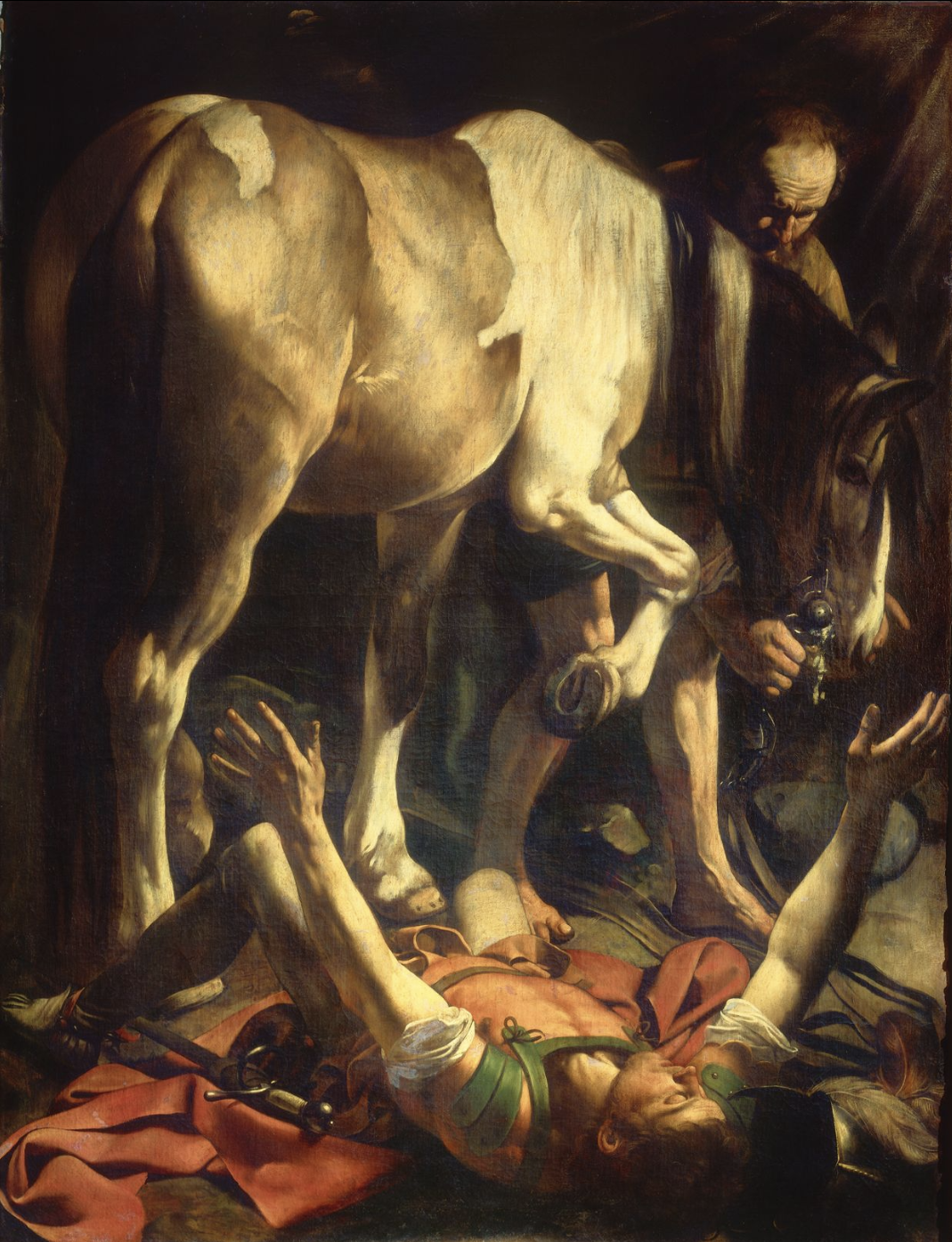
Calling of Saint Matthew, Caravaggio, ca. 1597-1601
Scene takes place in a grimy Roman tavern, unique scene. Christ calls upon ___ to serve him, pointing him out in a table. St. was originally a tax collector, seems like a strange follower to have. Light flowing in goes right to the future St, Peter blocks Christ and the St, seeming to act as an intermediary. Christ points to the St. but he is not very visible, he seems confused. Hand of Christ is very relaxed, seems to be a callback to the Sistine Chapel creation of man section. Seems to be a call back to how Christ is sometimes called the “new” Adam.
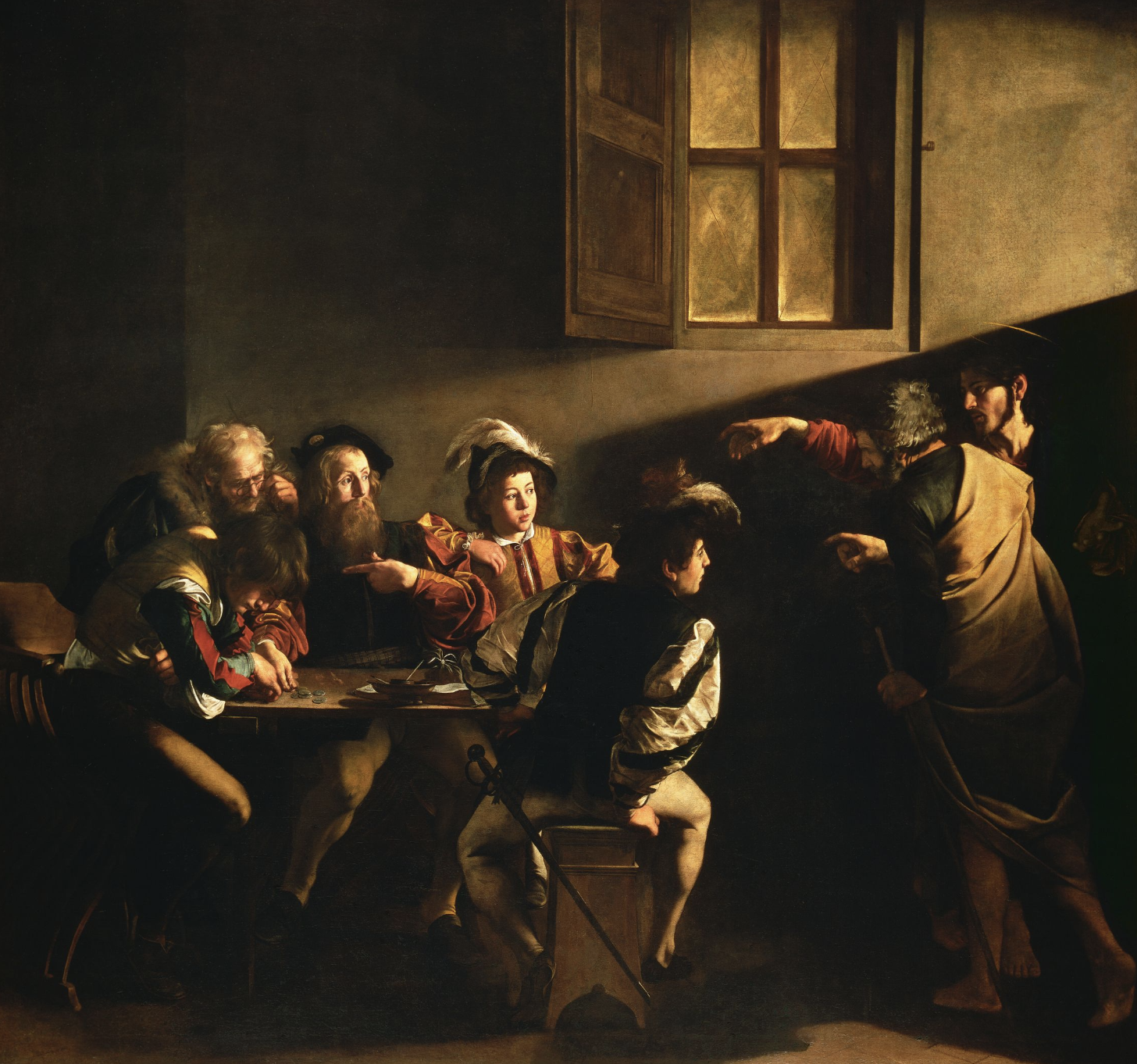
Entombment, Caravaggio, ca. 1603
St. Filippo was a reformer who wanted to bring more people into the church and created the fathers of the Oratorians. Church was trying to investigate if he deserved to be canonized, some claimed when he gave transubstantiation, he would levitate and his cup would have wine in it. He also wanted the art of the church to appeal to ordinary people (genre scenes!). Pieta is typically a figure of the Virgin Mary with the dead Christ laid on her lap. Artist didn’t want a static pieta and instead showed the burial of Christ as more of a narrative, figures pop out of the dark background and the dark wall of the chapel. The Virgin Mary is wrinkled, two men struggle with the limp, dead body of Christ, all the figures are very ordinary and not dressed up. This piece would have been placed below an altar and as priests were blessing the wafers and the drink to be the body of Christ, people would have seen the “floating’ images of Christ and believed in the power of Christ.
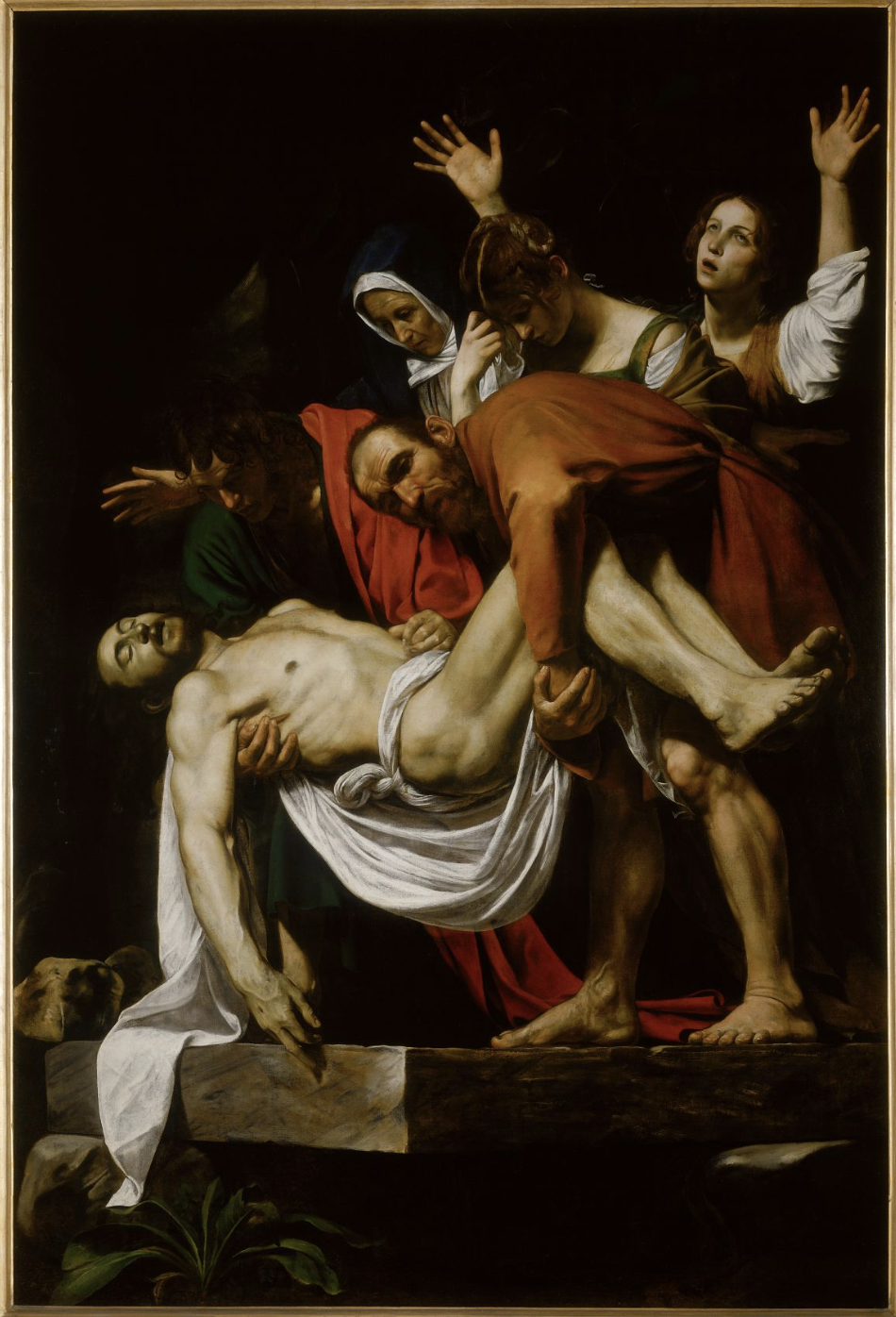
Las Meninas (The Maids of Honor) by Velasquez, Baroque Spain
Painter was King Philip IV’s court painter. Scene is more spontaneous and not as posed as other works. Scene appears to be in the painter’s studio with the infanta (princess) at the center. Her maids are working to sooth her (noble women, hold a very prestigious position), man in the back is the queen’s quartermaster. The wall is covered in paintings but one in the back is actually a mirror with a reflection of the queen and the king, seems to suggest they are also posing in the space where the viewer stands. Multiple different interpretations of the work, could be princess posing, king/queen posing for a different work (everything is from the king’s pov), third is that this is a painting about painting (works in the back show myths of Greek gods and humans who challenge them). Artist wanted to be admitted to the Order of Santiago (one must have pure blood and must have never been compensated for their work). Painter puts himself in the background in elegant clothing, trying to show himself as on the same level as all others in the royal court. Painting was made before artist’s induction into the Order but his clothing contains a red symbol of the cross, a symbol of the order, was added later. King had this painting hung in his private office.
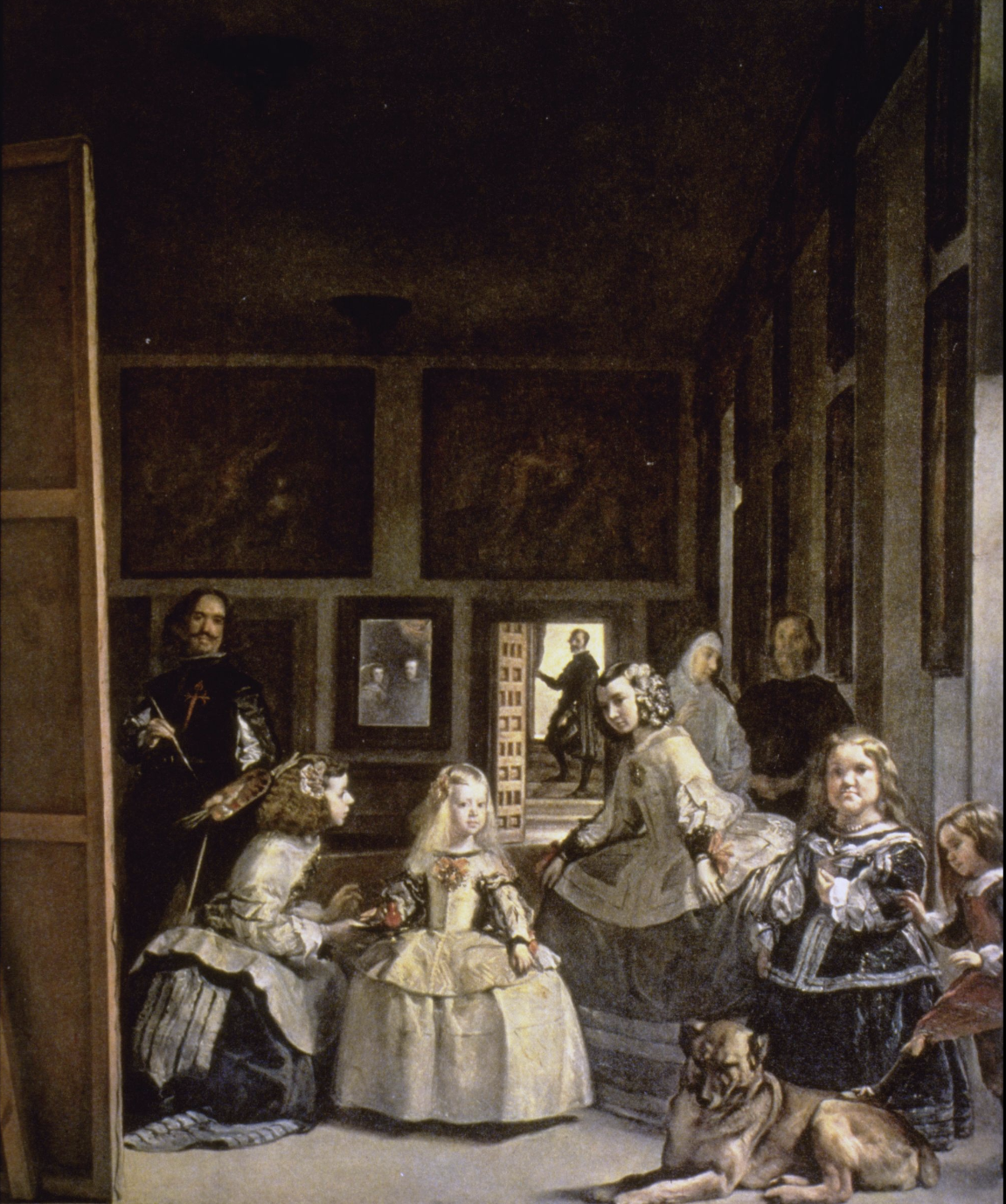
View of Haarlem from the Dunes at Overveen by van Ruisdael, Dutch Republic, Baroque
Created for an art market based on speculation (smaller-scale painting since main audience is middle-class patrons). Features a church in the background, Protestant nation but 1/3 stayed Catholic and another 1/3 were other religions bcs of tolerant nature of this republic. Foreground showcases sand dunes but where the viewer is standing would be the sea, 2/3 of painting is sky. A lot of the Netherlands was below sea level so even though we are looking up, we see things below the horizon line. Linen was bleached in this area so there are fields of linen, may suggest this painting could have been a souvenir for people coming to visit. ___ were proud of their land because unlike most of Europe, 50% of the land was held by non-aristocratic people.
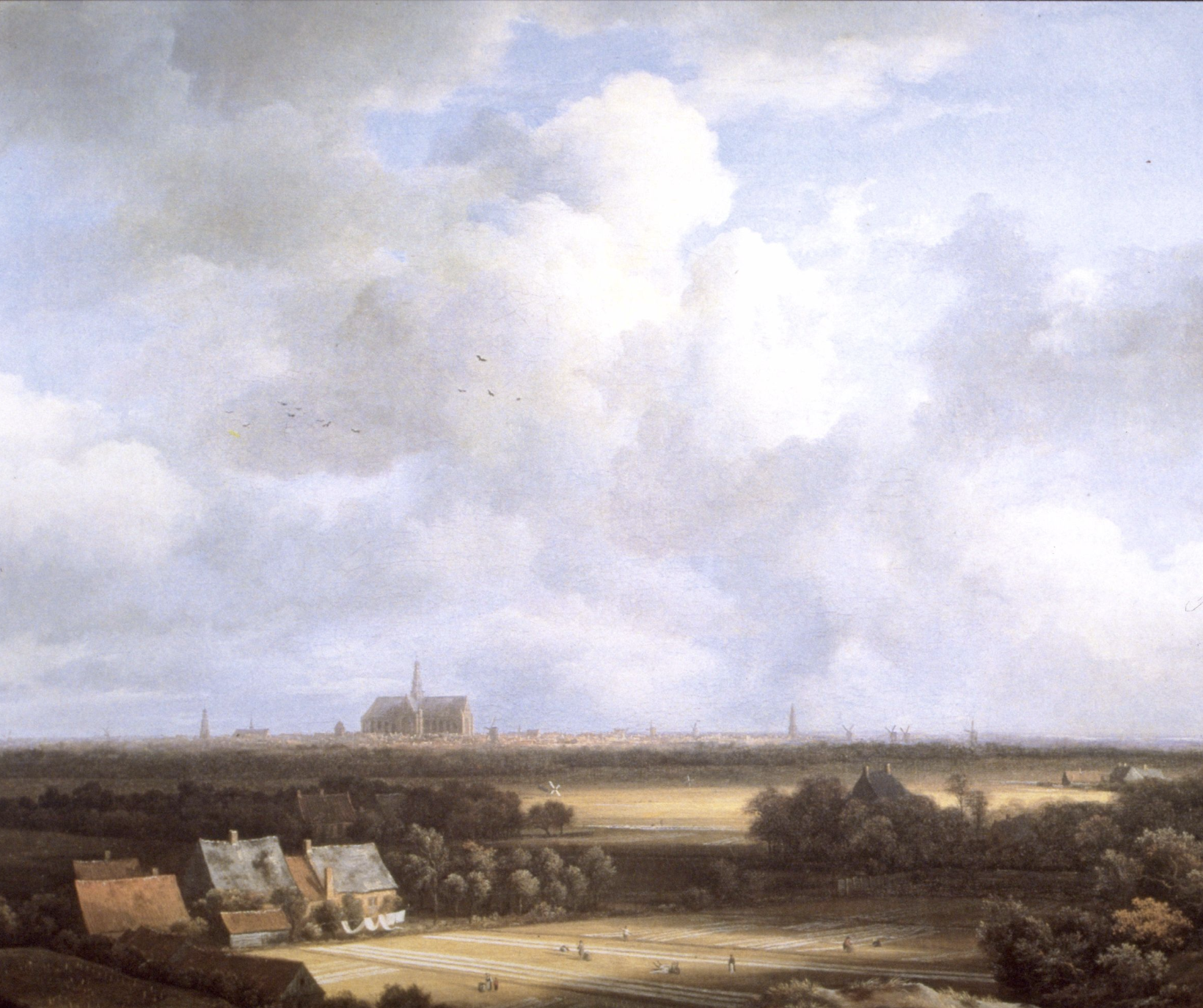
The Anatomy Lesson of Dr. Tuple by Rembrandt van Rijin, Dutch Republic, Baroque
Members of the anatomy guild in Amsterdam exclusively dissected criminals because it was the exception to the churches views on dissection since they thought people would be resurrected. Once a year, the guild would hold a public lecture where they would dissect the body of a criminal who was hung earlier that day. Main dr. would lecture while assistants performed the actual dissection. Every 5-10 years, guild would commission a portrait to hang in the guild hall. Everyone in the painting contributed, if one wanted a more prominent place in the portrait, they would pay more. The corpse was a 28 year old man, hung for assault and battery, body is foreshortened. Figures here would have wanted to be recorded as among Amsterdam’s scientific elite.
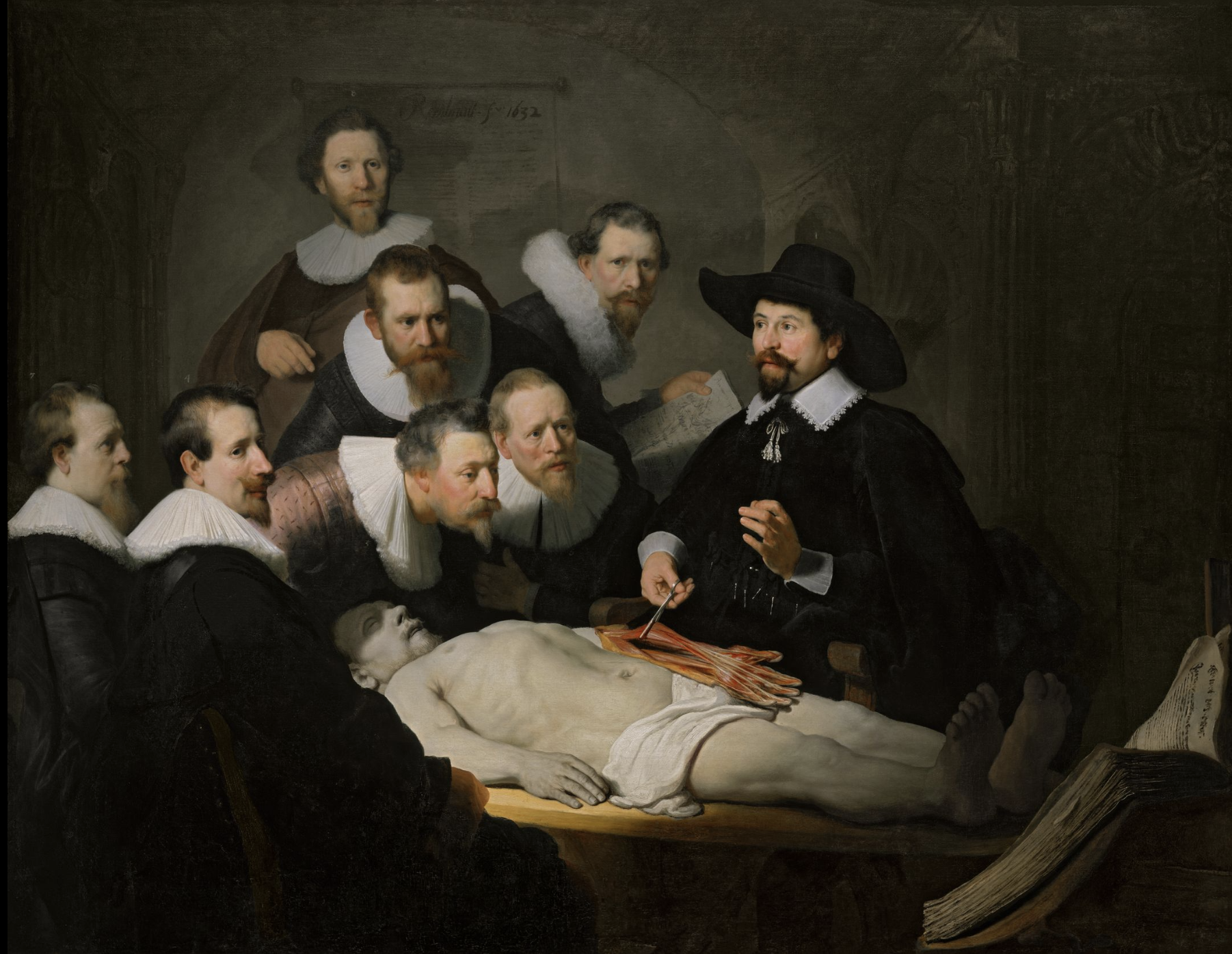
Still Life with Flowers, Fruit, and Insects on the Edge of a Forest by Ruysch, Dutch Republic, Baroque
Artist was female, the daughter of a scientist who was the head of the botanical garden in Amsterdam. She became a court painter for a German Duke but she never lived at the court, instead she would send paintings down. Still life paintings allowed her to indulge in her interest in science. This painting resembles a forest floor, there is an oak tree on the right and lots of imported fruits on the floor. There are a variety of animals and insects and all of the fruit is perfectly ripe and in bloom even though they are from different seasons.
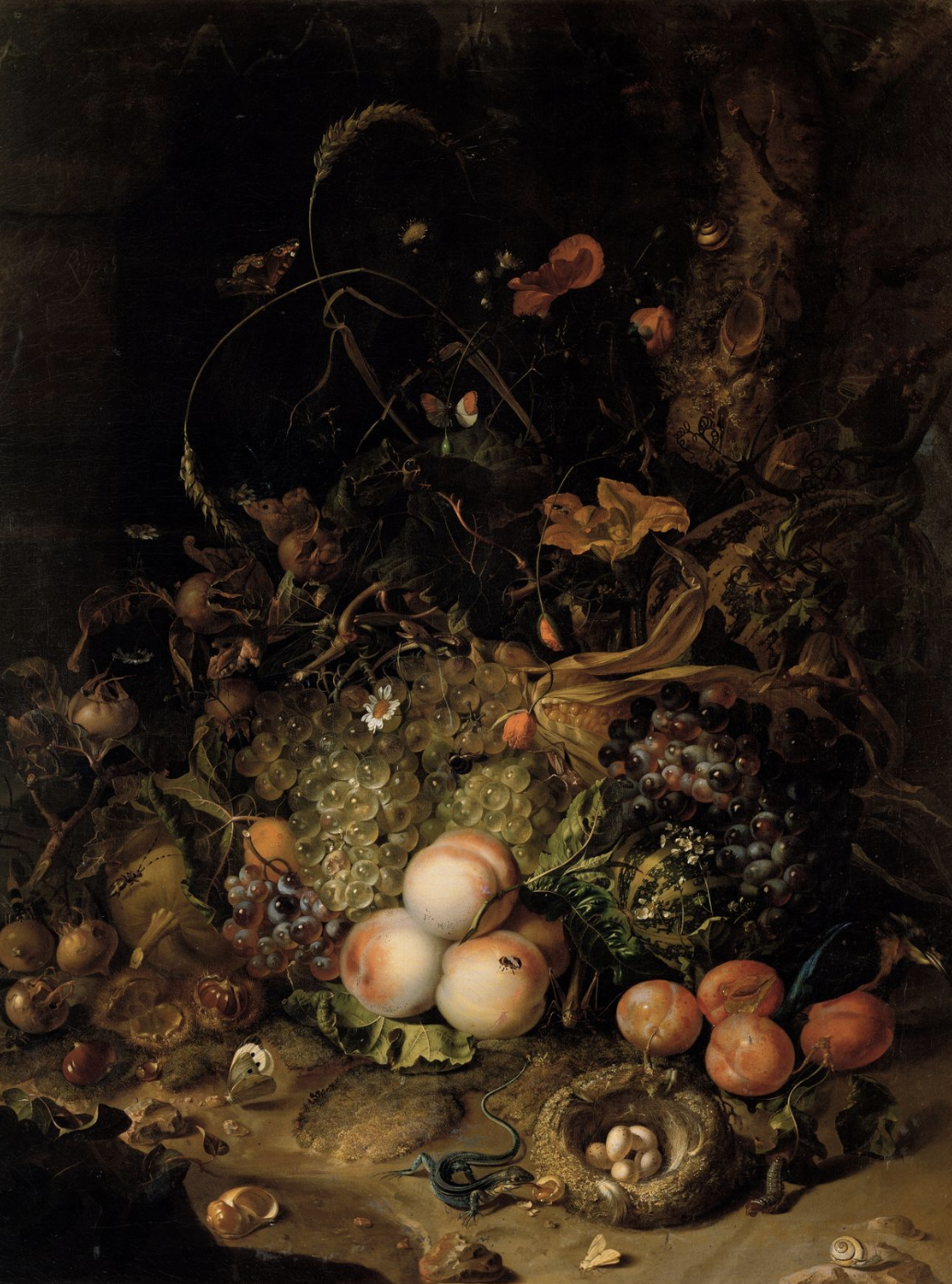
The Bedroom by de Hooch, Dutch Republic, Baroque
Speculated that this is the artist’s home, room does have a bed but it’s in a box, would have been used for a variety of functions. Middle class home: tiled floor, split Dutch door. The house wife is making the bed in the morning and there is a chamber pot realistically lighted. The child has come out, light shines through their hair and we get to see the simplicity and beauty of this family’s home and their life. We also see that the Dutch like having their children around (unlike other European countries where children were immediately sent for apprenticeships at young ages)
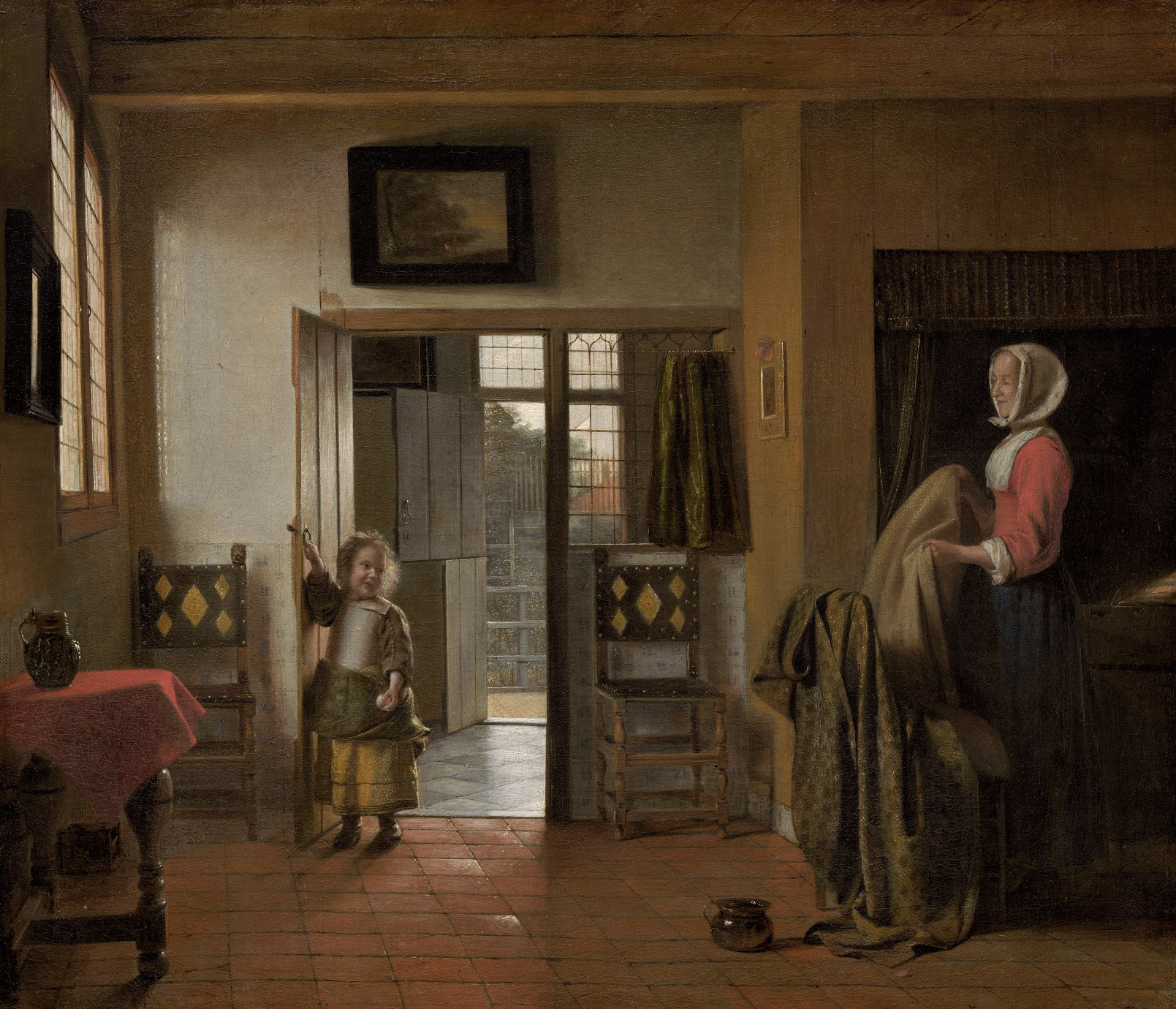
Celebrating the Birth by Steen, Dutch Republic, Baroque
Scene of disorder, provides a view into a middle class home. If one had servants, the kitchen would be put far away from the rest of the quarters but if the house wife was in charge of the kitchen, it would be closer to the rest of the home. Room itself is very nice: marble floors, pewter plates and kitchenware. Often the kitchen would include a bed because the kitchen was the warmest place in the home. A lot of people have to see the birth of the baby, some are talking to the mother but many are simply partying. The father holds the baby and looks uncomfortable as women come to ask him for money for more supplies. The lady on the right hands limp sausages on the fireplace, there is a man in the background slipping out who holds up two fingers behind the baby’s head as a sign of the devil. He has cuckolded the true biological father of the baby.
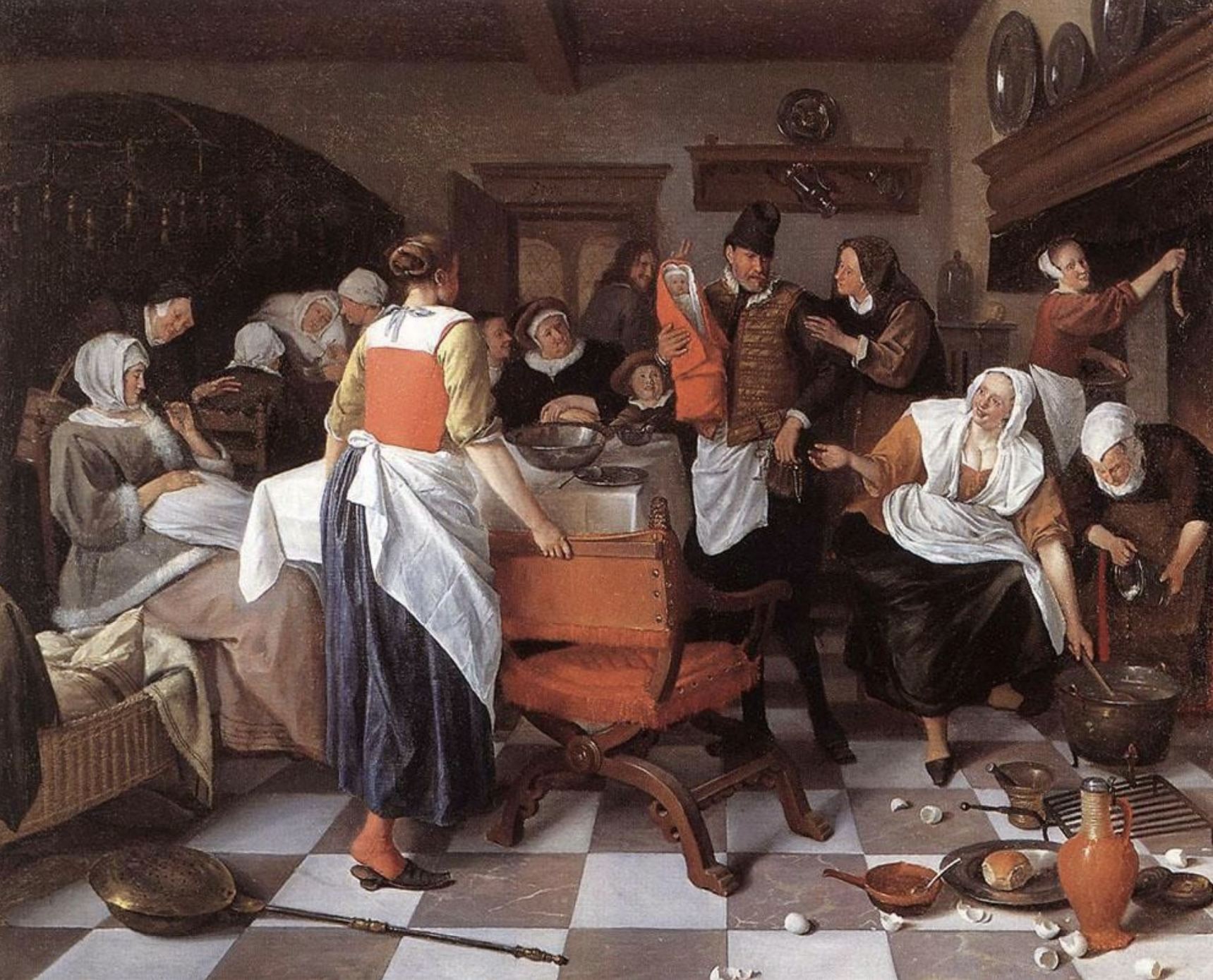
Illustrations from the Encyclopedia, Commissioner Diderot, first edition, The Enlightenment
Middle class figure fathered human knowledge into the first Encyclopedia, which had a series of articles that had information that could then be passed on to others. Many of these articles would be illustrated. Some articles covered religious subjects but through a scientific lens: scientists were commissioned for an article about Noah’s arc that included calculations of how much space was needed for the animals, how long Noah and his sons would be working every day, etc.
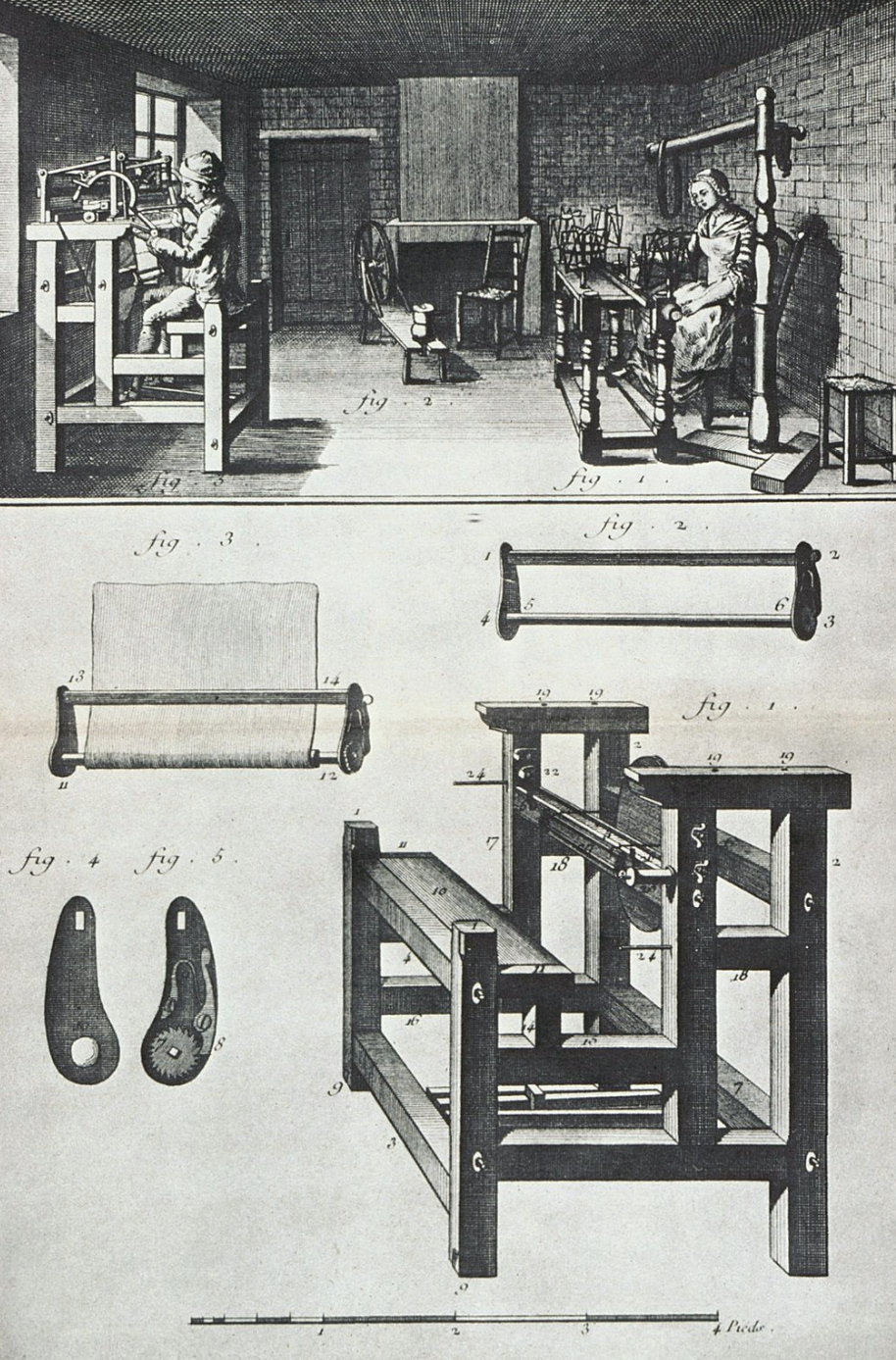
A Philosopher Giving a Lecture on the Orrery by Wright of Derby, England, The Enlightenment
During this period, the English were the earliest country to experience the innovations of the industrial revolution. Very large oil painting with rich contrasts and shades, likely painted on speculation. ____ is meant to be a model of our solar system with the lamp in the middle hidden by a figure in the front. Figure in red gives the lecture, writing figure is a cartographer. Most of the figures are meant to be average people. Figures loom out of the darkness, there is almost no background. Inspiration comes from Caravaggio’s style. Has a similar light to the Conversion of Saint Paul but instead of a religious revelation, these people are having a scientific revelation. Highlights how important and popular these lectures were at the time. Lots of social mobility: the man in red used to be a clock maker but now he’s a powerful engineer.
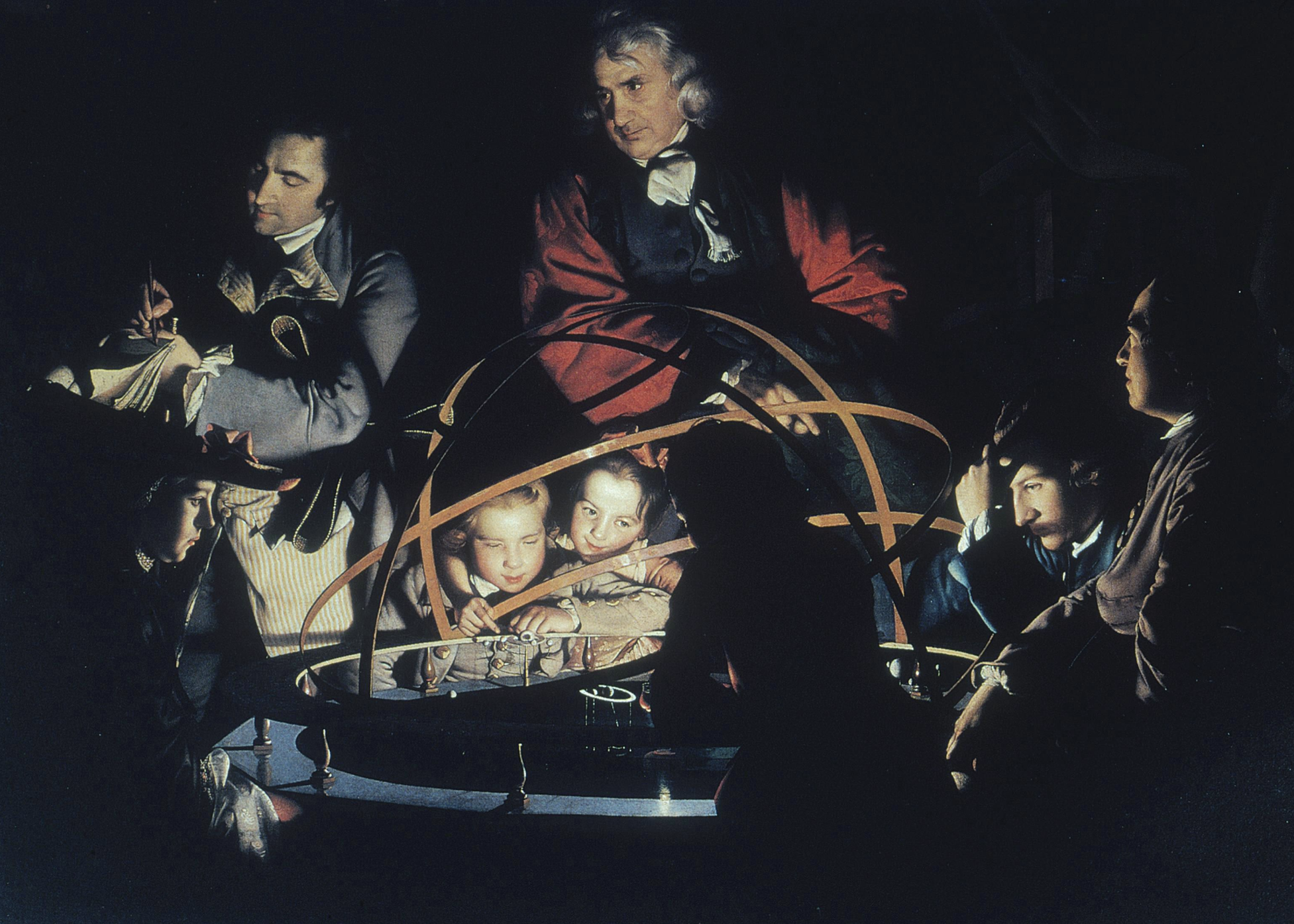
Arkwright’s Cotton mill by Wright of Derby, England, The Enlightenment
____ commissioned the artist for this painting, was originally a barber but helped revolutionize the textile industry. Factory is painted at night during a full moon (which peaks out from the clouds), factory is nestled in the valley, very idyllic view. Factory would have been running 24 hours a day, hence the lights turned on. Conditions were poor, many getting diseases from breathing in cotton, losing hearing, injury rate was high, etc. Children were also a large portion of the employee base. Industrialization also pushed out local artisans who could not compete with the quick rate of quality clothing that was being pumped out
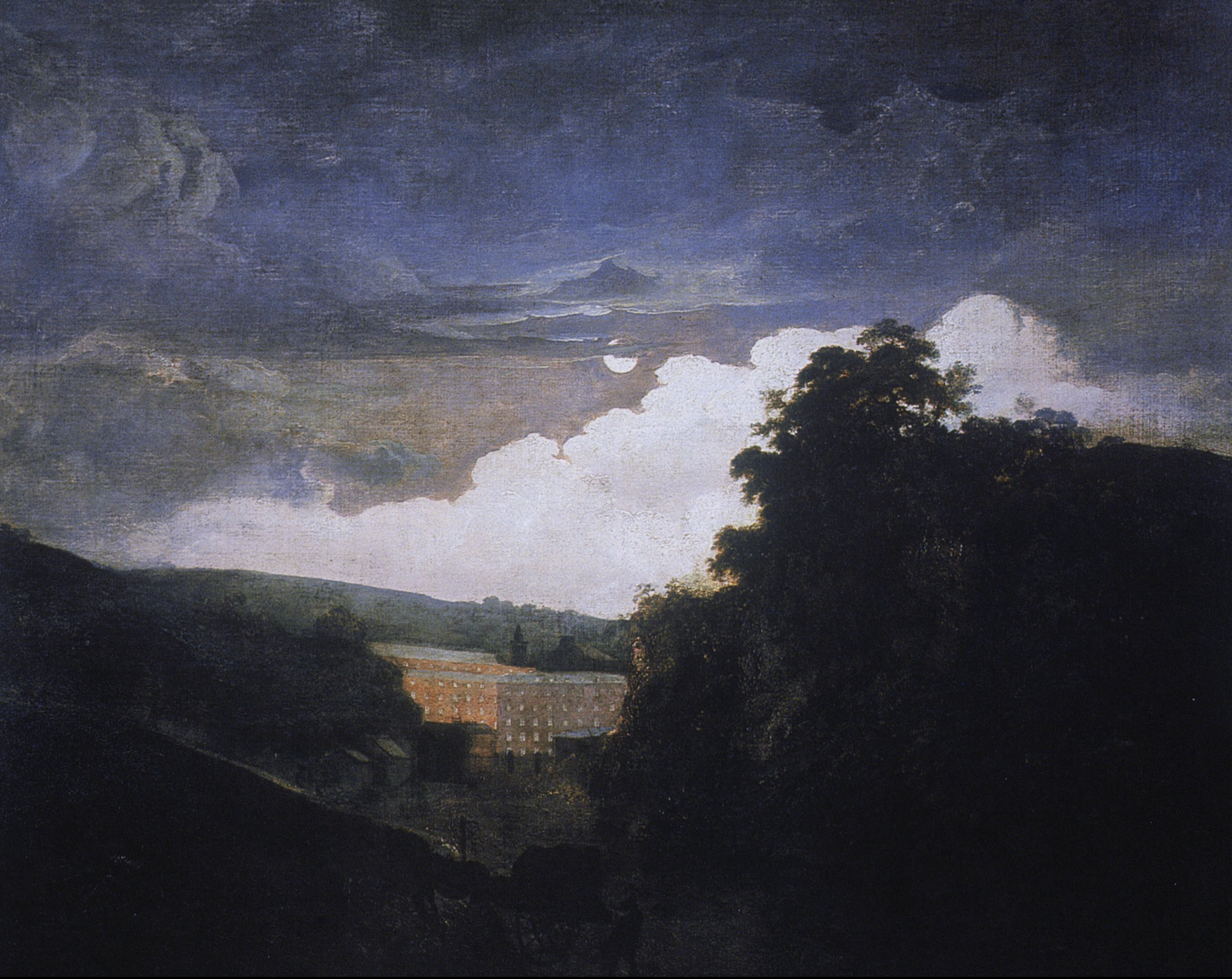
Stourhead Park by Horae II and others, England, the Enlightenment
English garden made partially in opposition to the opulent, planned nature of the Gardens at Versailles. Gardens belonged to a banker who enjoyed reading pastoral poetry, especially the Roman kind. No central axis, completely nature, irregular lake, no boundaries visible. One’s view constantly changes as they walk around the garden. Had many different statues, structures, etc. placed throughout the gardens, called foleys because they were pretty but useless. Holds a small Pantheon style building with a dome with an oculus and coffers. Foleys are meant to provoke thought as one walks through the garden. During this time, people realized beauty is relative (not just Roman or Greek art that was “perfect”), mix of styles reflects this
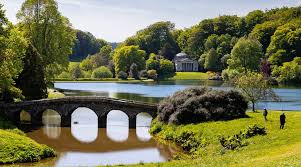
Saltworks and Ideal City of Chaux by Ledoux, France, The Enlightenment
Artist was commissioned by the king to design this area and used it to design his ideal city, creating engravings of it. Believed a circle was the ideal shape and that’s why he built this city in the way he did with a boulevard surrounding it. All of the buildings were inspired by classical Greek and Roman architecture. Thought that the factory building should be decorated but still show its true purpose. Supervisors and workers all had the same style of home, only difference was size. Every worker also got a plot of land to grow vegetables on.
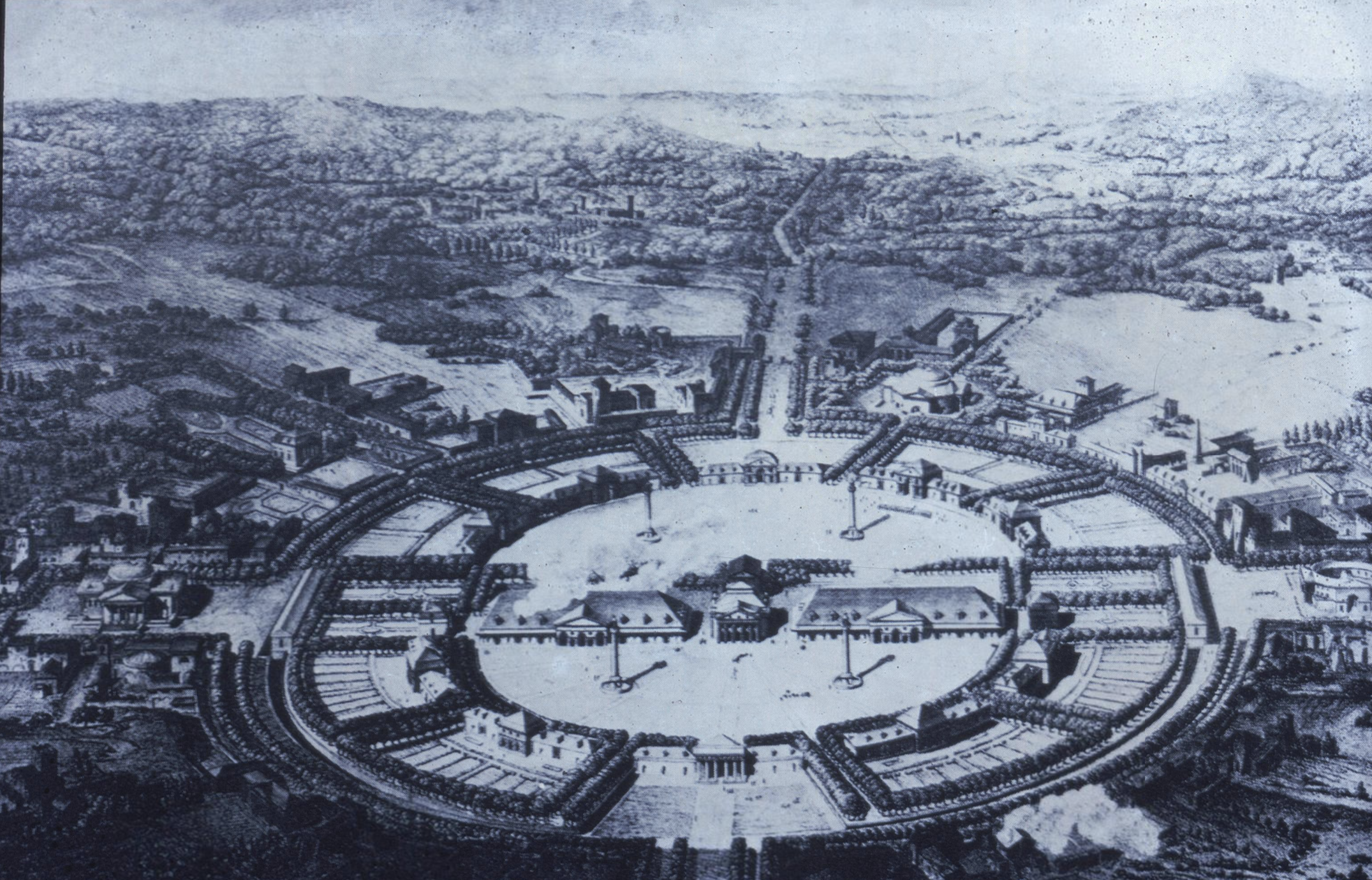
Oath of the Horatii by David, France, Neoclassicism
Huge painting, artist was originally a Rococo artist but studied Roman and renaissance art later. Subject is an old Roman story that had been translated into a play in the artist’s home country. Tells that tale of two cities about to go to war who settle the dispute by pitting three men against the other city’s three men. Three sons were chosen to represent Rome, they are on the left. Arches organize the painting into three distinct groups. Figures of the men are very sharp, muted colors except for pops of red. They are so united they blend together but we can clearly see their hands and the oaths they are making with them. Women on the right give us the emotional aspect of the story: the woman on the right is their sister but she is engaged to a man who will fight for the other city, the woman on the middle is the sister of the man who and the woman on the left is from the family, represents how the families are intermixed. They are slumped over with muted colors: shows the cost to both families that this fight will bring. King bought this painting in an attempt to appear more progressive. Inspirational story, idea is that art should teach people something: people must put the community good over their own interest.
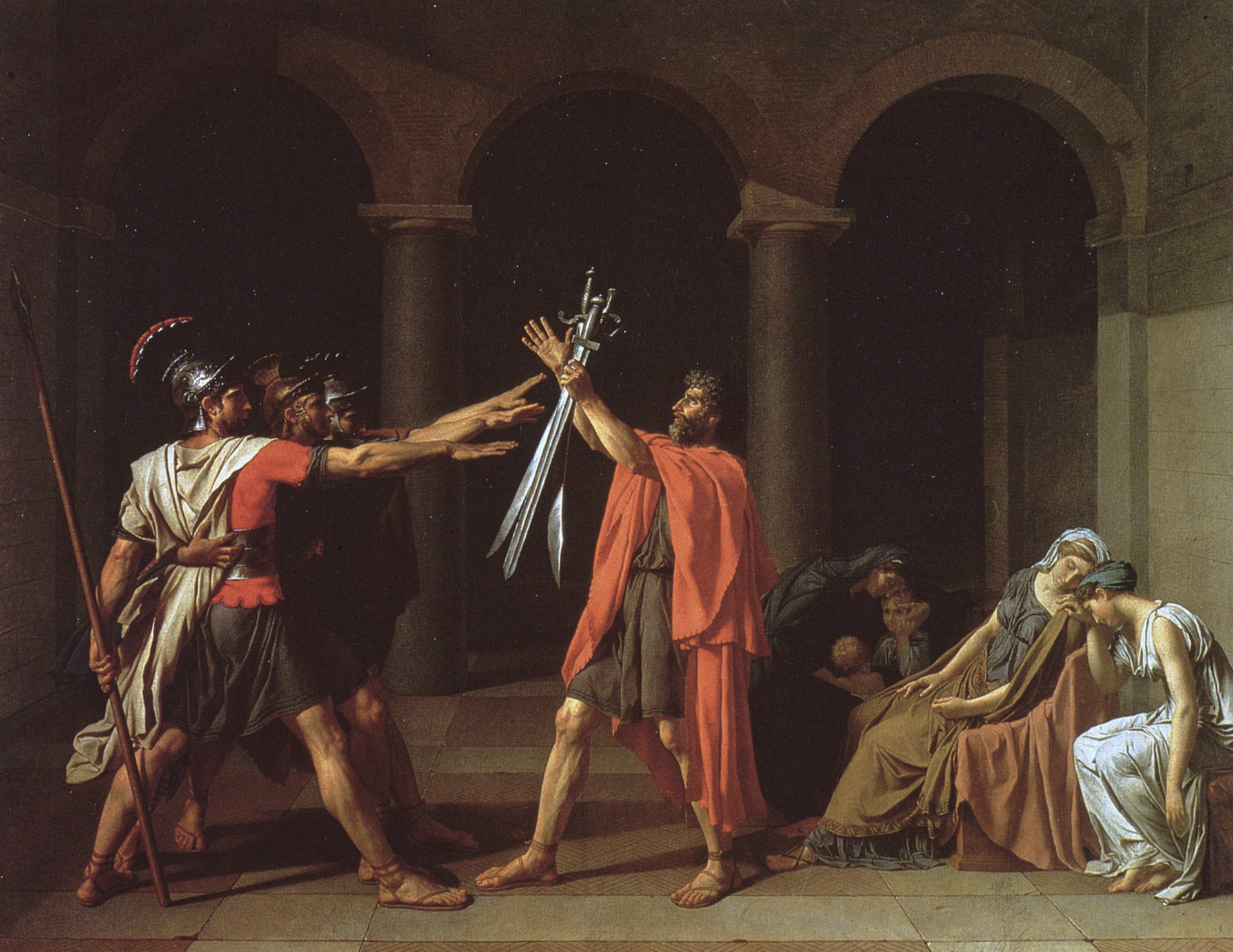
The Death of Marat by David, France, Neoclassicism
Artist was initially going to wait out the revolution in Italy but decided to stay and began to become a revolutionary himself. Subject was a revolutionary and progressive who was a friend of the poor. At some point either in jail or while hiding in the sewers, he contracted a skin disease that he could only soothe by taking medicinal baths. He had set up a home office in his bath tub with a small crate on the side to serve as a desk. A woman came to his door claiming to have information but had a knife and stabbed him, seen as a martyr, the knife is visible in the painting. No background, stripped down to its most essential elements. Table appears like a tombstone. Light falls on the subject’s face, looks like a peaceful scene, may be akin to other religious works where Christ is dead but looks peaceful in death. Revolution believed revolution was a myth and people voted to abolish Christianity. In a way, artist seems to have painted subject matter as a substitute saint, all of his items were on display at his funeral like relics. Painting was hung over his grace, people may have “prayed” to it. Artist started out glorifying ancient Romans but ended painting heroes of his time.
